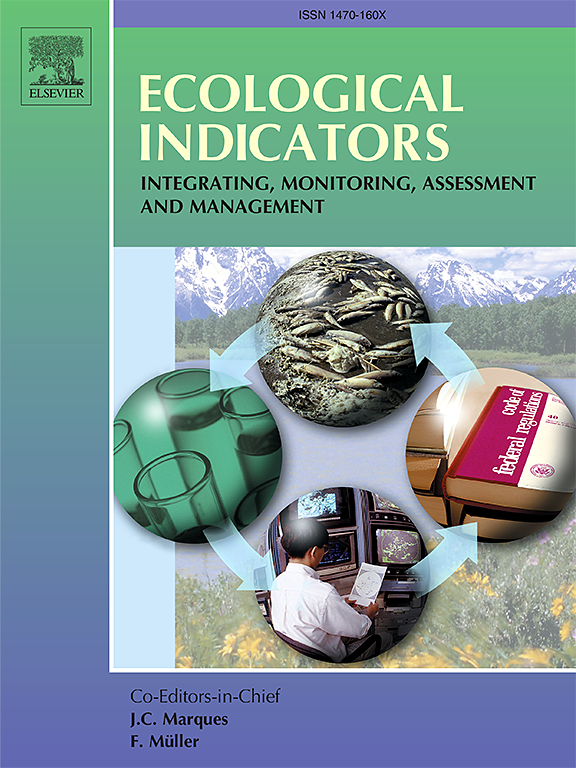Selecting surrogate species for species-based conservation in the Plateau-Mountains-Basin transition region of southwestern China
IF 7
2区 环境科学与生态学
Q1 ENVIRONMENTAL SCIENCES
引用次数: 0
Abstract
Urgent conservation action is needed to safeguard biodiversity. One promising approach is the use of surrogate species in species-based conservation strategies, which can indirectly benefit other species that share similar habitat requirements. However, the lack of spatial quantification methods to accurately select representative species at large-scale regions has limited the application of surrogate species in conservation. To address this, our study presents two methods to quantify and select surrogate species for species-based conservation in the Plateau-Mountains-Basin transition region of China (∼486,000 km2). These two methods follow the same selection process, moving from priority conservation species to refined candidate species, and finally to surrogate species. Specifically, we compiled a species list of priority conservation plant species and used multiple datasets to predict the area of habitat maps for these species. We found 140 priority conservation plants distributed around the Sichuan Basin. Building on their distributions, we selected 17 surrogate species using indicator value analysis, considering 18 different subregion combinations and 4 habitat overlap scenarios. Alternatively, we applied a second method, selecting 19 surrogate species based on factor analysis, while considering the correlation analysis of pairwise species combinations. The richness map of these surrogate species shows a distribution pattern similar to that of the 140 priority conservation plants. Based on the distribution patterns of surrogate species, we identified conservation hotspots in the mountains around the Sichuan Basin. By utilizing the fine-scale area of habitat maps, our study offers valuable strategies for selecting surrogate species in species-based conservation efforts aimed at safeguarding biodiversity in ecologically critical regions.
在中国西南部高原-山地-盆地过渡区为基于物种的保护选择替代物种
需要采取紧急保护行动来保护生物多样性。一种很有前景的方法是在基于物种的保护战略中使用代用物种,这可以间接惠及具有相似栖息地要求的其他物种。然而,由于缺乏空间量化方法来准确选择大尺度区域的代表性物种,限制了代用物种在保护中的应用。针对这一问题,我们的研究提出了两种方法来量化和选择中国高原-山地-盆地过渡区(∼48.6 万平方公里)的代用物种,用于基于物种的保护。这两种方法的选择过程相同,都是从优先保护物种到细化候选物种,最后到替代物种。具体来说,我们编制了一份优先保护植物物种清单,并利用多个数据集来预测这些物种的栖息地地图面积。我们发现四川盆地分布着 140 种重点保护植物。根据这些植物的分布情况,我们采用指标值分析法选出了 17 种替代物种,并考虑了 18 种不同的次区域组合和 4 种生境重叠情况。此外,我们还采用了第二种方法,在考虑物种配对组合的相关性分析的同时,基于因子分析法选出了 19 个代用物种。这些代用物种的丰富度分布图与 140 种重点保护植物的分布模式相似。根据代用物种的分布模式,我们确定了四川盆地周围山区的保护热点。通过利用精细尺度的栖息地分布图,我们的研究为在以物种为基础的保护工作中选择代用物种提供了有价值的策略,旨在保护生态关键地区的生物多样性。
本文章由计算机程序翻译,如有差异,请以英文原文为准。
求助全文
约1分钟内获得全文
求助全文
来源期刊

Ecological Indicators
环境科学-环境科学
CiteScore
11.80
自引率
8.70%
发文量
1163
审稿时长
78 days
期刊介绍:
The ultimate aim of Ecological Indicators is to integrate the monitoring and assessment of ecological and environmental indicators with management practices. The journal provides a forum for the discussion of the applied scientific development and review of traditional indicator approaches as well as for theoretical, modelling and quantitative applications such as index development. Research into the following areas will be published.
• All aspects of ecological and environmental indicators and indices.
• New indicators, and new approaches and methods for indicator development, testing and use.
• Development and modelling of indices, e.g. application of indicator suites across multiple scales and resources.
• Analysis and research of resource, system- and scale-specific indicators.
• Methods for integration of social and other valuation metrics for the production of scientifically rigorous and politically-relevant assessments using indicator-based monitoring and assessment programs.
• How research indicators can be transformed into direct application for management purposes.
• Broader assessment objectives and methods, e.g. biodiversity, biological integrity, and sustainability, through the use of indicators.
• Resource-specific indicators such as landscape, agroecosystems, forests, wetlands, etc.
 求助内容:
求助内容: 应助结果提醒方式:
应助结果提醒方式:


